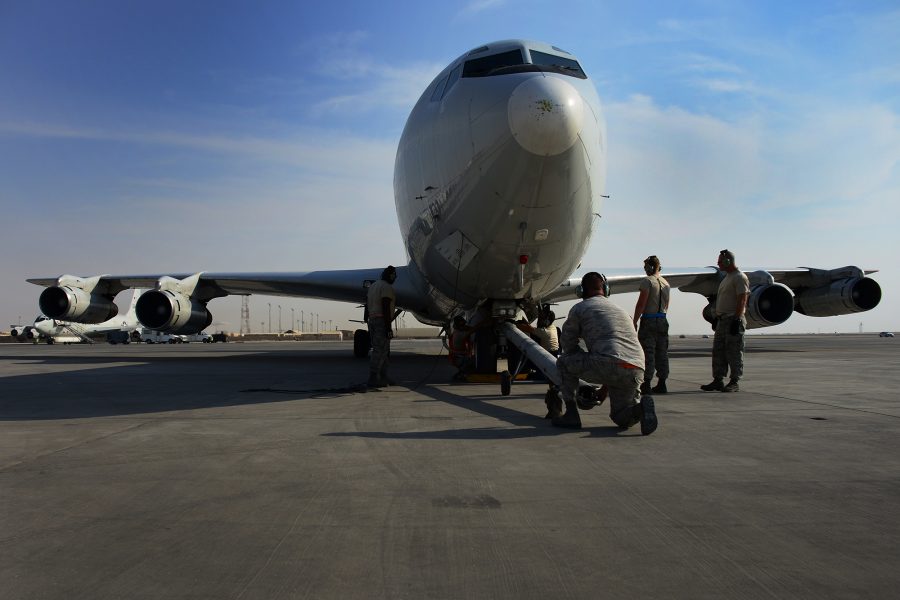Air Combat Command has pulled its E-8C Joint STARS fleet out of the Middle East after 18 years, another change for the platform that recently saw its long-running replacement effort canceled and is ramping up in-house maintenance.
“Joint STARS has been continually deployed to the [US Central Command] area of responsibility every day since November 2001,” according to a press release from Robins AFB, Ga., where the fleet is based. “Since then, they have flown 10,938 sorties, equaling 114,426.6 combat flying hours in support of nearly every CENTCOM operation including Enduring Freedom, Iraqi Freedom, Freedom Sentinel, and Inherent Resolve.”
Joint STARS collects and sends information that helps direct ground forces and can track moving targets on land, a mission crucial to Army operations. Joint STARS crews flew every other day in CENTCOM, totaling more than 100 combat missions since June, according to an Oct. 9 press release.
The last E-8C jet left Al Udeid AB, Qatar, on Oct. 1 amid a broader reshuffling of troops in the region as combat operations against the Islamic State group wind down and as the US largely leaves Syria.
“The priorities for the National Defense Strategy have higher demand signal for JSTARS support to other [combatant commands], but JSTARS stand ready to provide support if their capabilities are needed,” ACC told Air Force Magazine. “We prioritize geographic combatant command requests by weighing current demand against National Defense Strategy priorities.”
The Pentagon declined to discuss where the 16 E-8Cs could focus the bulk of their time going forward, but the NDS centers on potential conflict with Russia and China in Europe and the Indo-Pacific. Joint STARS can still deploy to CENTCOM in the future if needed, a command spokesman said.
In the meantime, CENTCOM says it still has “a number of manned and unmanned [intelligence, surveillance, and reconnaissance platforms in theater to provide situational awareness to US forces and to deliver valuable battlefield intelligence” in the absence of Joint STARS. While the Air Force had started work to add ground moving target indication capability to the MQ-9 Reaper, Joint STARS is the only platform dedicated to the GMTI mission.
Leaving CENTCOM will allow the platform to fly missions in other parts of the world while keeping up with training, maintenance, and other readiness needs.
Col. Konata Crumbly, commander of the 116th Air Control Wing at Robins, said in an email that all training is the same, so pivoting to other theaters won’t change the E-8C’s training and maintenance needs. The 116th is an Air National Guard wing that operates Joint STARS alongside the Active Duty 461st ACW.
Ending the CENTCOM deployment isn’t expected to change the maintenance workload for the jets, which are based on Boeing 707 airframes that had already accumulated up to 60,000 flight hours by the time they were repurposed as USAF battle management planes.
The Air Force has begun tackling more heavy maintenance at Robins rather than relying on Northrop Grumman, which traditionally handles in-depth sustainment but has been criticized for keeping the E-8C in depot for too long.
The service now expects that Joint STARS can continue flying into the 2030s, instead of running out of service life early that decade. The platform will become part of the initial stages of the Advanced Battle Management System, the plan that in 2018 replaced the effort to buy new aircraft for the E-8C mission.
The Joint STARS recapitalization program was cancelled in part because the jets would be vulnerable against surface-to-air missiles and other threats wielded by more advanced adversaries than those in the Middle East. Instead of purchasing a newly designed fleet with an upgraded radar, the Air Force is exploring how to spread battle management duties to a network of other aircraft, satellites, and ground systems. The idea is that if one node of the network is taken out, it wouldn’t affect the service’s ability to disseminate information on missions like force protection, defensive operations, overwatch, and combat search and rescue.
Crumbly said leaving CENTCOM won’t affect development of ABMS, which is also expected to be run out of Robins.
“Our departure from CENTCOM is not related to future missions including ABMS,” Crumbly said. “Whatever future missions, to include ABMS, we are asked to fulfill, we will approach it with the same level of commitment and professionalism we have shown with our JSTARS mission in CENTCOM and other areas of the world since this program was established.”
This story has been updated to correct the name of the Advanced Battle Management System.

